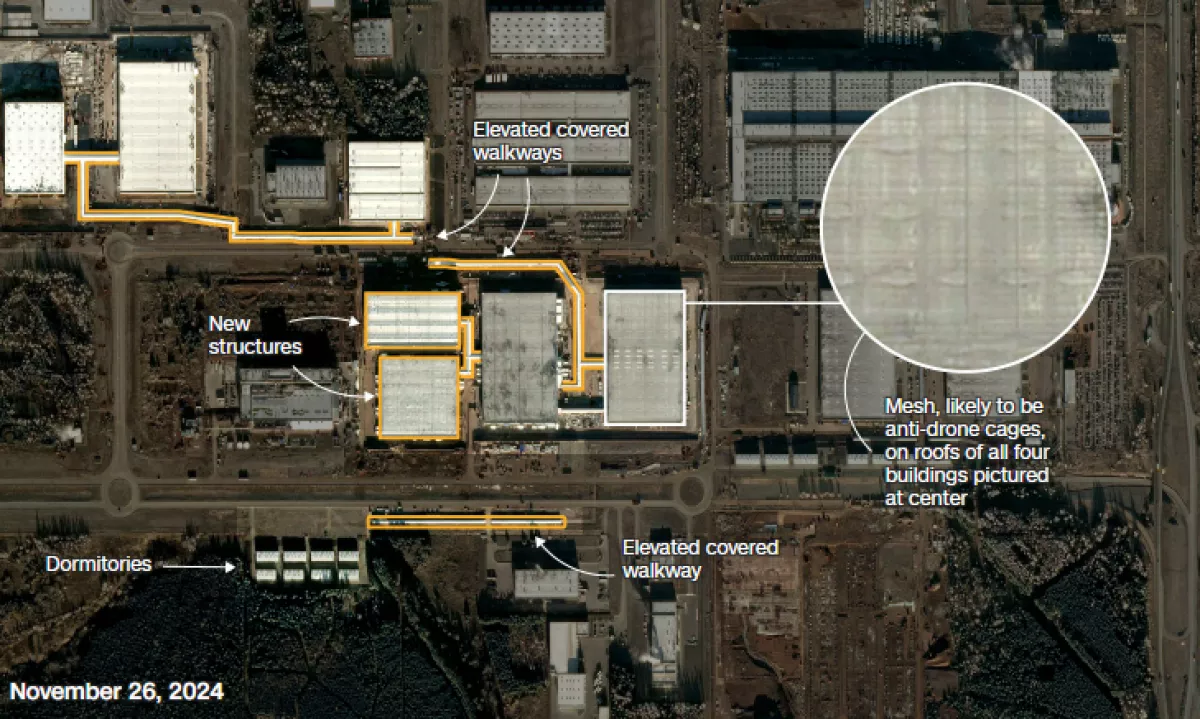Ukraine faces surge in drone strikes as Russia's Alabuga factory expands production, CNN reveals PHOTO
As Russia intensifies its use of drones in the ongoing war against Ukraine, the scale of the threat continues to grow, with new details emerging about the expansion of a secretive Russian drone production facility.
The Alabuga Special Economic Zone, located in Tatarstan, has become a pivotal site for manufacturing Iranian-designed Shahed drones, which are now flooding Ukrainian airspace in large numbers, Caliber.Az reports via CNN.
Volunteer Ukrainian air defence units, composed of judges and other professionals, are being deployed to defend Kyiv from these persistent attacks. Despite their determination, these volunteers face an increasingly difficult task.
Ukraine’s military intelligence reports a sharp rise in drone strikes, with the number of attacks escalating from 400 in May to over 2,400 in November. The drone assaults are not only more frequent but also more complex, as Russia adapts its tactics to overwhelm Ukrainian defences.
The Alabuga factory, once a hub for Western businesses, has pivoted to military production, significantly expanding since the war began. Satellite images reveal that the factory’s production capacity has increased by 55%, with new buildings and security measures put in place. This factory now produces not only the Shahed-136 drones, but also “decoy” drones known as Gerbera.

These low-cost drones, made from plywood and foam, are designed to trick Ukrainian air defences and overwhelm them with a multitude of false targets. Estimates suggest that Russia aims to produce up to 10,000 of these decoys by the end of 2024, almost double the number of Shaheds. With each Gerbera costing a fraction of a Shahed, these decoys are seen as an affordable strategy to exhaust Ukraine's defence resources.
The factory’s rapid expansion reflects Russia’s broader efforts to increase its military production, which, according to experts, now outpaces the European Union in terms of weapons and ammunition. Ukraine, on the other hand, faces mounting pressure as it defends against this influx of drones, with many of these UAVs now being armed with thermobaric warheads, capable of causing even more destruction.
Satellite imagery and intelligence have also revealed the growing role of China in supporting Russia’s drone war efforts. Chinese companies have provided critical parts, materials, and production equipment for the Shahed drones. The US has already sanctioned Chinese companies involved in drone production, but the extent of China’s support is a growing concern, particularly as new logistical connections are being established between Russia and China, designed to transport materials for military production.
Despite these challenges, Ukraine’s air defence has been largely effective, with only 5% of Shahed drones reaching their intended targets. However, the scale of the Russian drone offensive is forcing Ukraine to use more advanced missile defence systems, a resource-intensive approach that is increasingly difficult to sustain.
As the war progresses, Ukraine’s allies face mounting pressure to curb the flow of components to Russia, especially from China. With the international community already imposing sanctions on the Alabuga zone, Ukraine is calling for broader efforts to disrupt the supply chains that fuel Russia’s drone production.
The growing threat from Alabuga’s factory underscores the strategic importance of disrupting these production lines, as Ukraine continues to fight back against an adversary that is adapting quickly and effectively. The expansion of Russia’s drone capabilities signals a protracted battle ahead, with Ukraine’s defence forces facing an uphill struggle to maintain control of their skies.
By Aghakazim Guliyev








